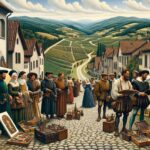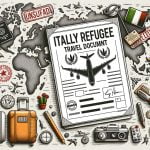Why did artists from other countries travel to Italy? Throughout history, Italy has held a special place in the hearts and minds of artists from around the world. From the Renaissance era to modern times, Italy has been a center of artistic innovation, inspiration, and opportunity.
The allure of Italy for artists can be attributed to various factors, including the influence of Italian masters, the beauty of the country’s landscapes and culture, and the patronage and support available for artists. This article will explore the reasons why Italy was a magnet for artists from other countries, as well as how their experiences in Italy shaped the course of art history.
Italy’s rich artistic heritage dates back to the Renaissance era when it was at the forefront of artistic innovation. Italian artists such as Leonardo da Vinci, Michelangelo, and Raphael created masterpieces that continue to inspire and awe artists to this day. The impact of these Italian masters extended beyond their own country, influencing artists from other countries who traveled to Italy to study their works and techniques.
In addition to the influence of Italian masters, artists were drawn to Italy by its artistic treasures such as the Vatican and The Sistine Chapel. These iconic landmarks housed some of the most renowned artworks in history and served as a pilgrimage site for artists seeking inspiration and spiritual enlightenment. Moreover, Italy’s patronage system provided financial support and opportunities for artists to create and showcase their work, making it an attractive destination for aspiring creatives.
The Renaissance Era
During the Renaissance era, Italy became the epicenter of artistic innovation, drawing artists from other countries to its vibrant and dynamic art scene. The period marked a significant shift in art, with a focus on humanism, classical antiquity, and the exploration of new artistic techniques. This cultural and intellectual movement had a profound effect on artists across Europe, prompting many to travel to Italy in search of inspiration and knowledge.
One of the primary reasons why artists from other countries traveled to Italy during the Renaissance was to study the works of Italian masters such as Leonardo da Vinci, Michelangelo, and Raphael. These iconic figures revolutionized art with their groundbreaking techniques and compositions, making Italy an invaluable learning ground for emerging artists seeking to improve their craft. The allure of learning directly from these renowned masters was a powerful motivation for artists to make the journey to Italy.
Moreover, Italian cities such as Florence, Rome, and Venice were hubs of artistic activity, offering unparalleled opportunities for collaboration and exchange among artists. The flourishing artistic communities in these cities provided a fertile environment for creative growth and exposure to diverse styles and perspectives. As a result, many foreign artists were drawn to Italy not only for individual artistic development but also for the chance to immerse themselves in a rich tapestry of ideas and innovations.
| Renaissance Artists | Impact on Foreign Artists |
|---|---|
| Leonardo da Vinci | Inspired foreign artists with his mastery of anatomy and scientific approach to art |
| Michelangelo | Impacted foreign artists with his monumental sculptures and frescoes, showcasing mastery in human form |
| Raphael | Influenced foreign artists with his harmonious compositions and innovative use of perspective |
The Influence of Italian Masters
During the Renaissance era, Italy was the epicenter of artistic innovation, attracting artists from all over the world. The Italian masters such as Leonardo da Vinci, Michelangelo, and Raphael were influential in shaping the course of Western art. Their innovative techniques and revolutionary approaches to art inspired artists from other countries to travel to Italy in search of new artistic knowledge and inspiration.
The Impact of Italian Art on Northern Europe
Italian art had a profound impact on the art scene in Northern Europe. Artists such as Albrecht Dürer from Germany and Hans Holbein the Younger from Switzerland were heavily influenced by the works of Italian masters.
They were particularly drawn to the advancements in perspective, composition, and use of light and shadow pioneered by Italian artists. The influx of these new ideas from Italy led to a transformation in Northern European art, leading to what is now known as the Northern Renaissance.
Bringing Italian Techniques Home
One reason why artists from other countries traveled to Italy was to study under renowned Italian masters. These artists sought to learn firsthand the techniques and methods employed by their Italian counterparts. After their return home, they would integrate these newfound skills into their own artwork, thus spreading Italian artistic influence beyond its borders. This cross-pollination of ideas between Italy and other countries resulted in a rich exchange of artistic styles and traditions that continues to be celebrated today.
Italy’s position as a center for artistic knowledge and innovation made it an attractive destination for artists seeking inspiration and artistic growth. The legacy of this period continues to resonate through the centuries, shaping the trajectory of art history across Europe and beyond.
The Vatican and the Sistine Chapel
Italy is renowned for its rich artistic heritage, and one of the most famous artistic treasures in the country is the Vatican and the Sistine Chapel. This section will explore why artists from other countries were drawn to Italy, particularly to the Vatican and the Sistine Chapel, and how these iconic landmarks influenced their work.
Artistic Inspiration
The Vatican and the Sistine Chapel are not only religious centers but also repositories of some of the greatest artworks in history. The awe-inspiring frescoes by Italian masters such as Michelangelo, Raphael, and Botticelli served as a wellspring of inspiration for artists from around the world. These masterpieces showcased unparalleled skill, creativity, and innovation, setting a standard that aspiring artists sought to emulate or surpass.
Access to Techniques and Materials
Another reason why artists flocked to Italy, specifically to the Vatican and the Sistine Chapel, was for access to specialized techniques and materials. Italian Renaissance artists were at the forefront of technical advancements in painting, sculpture, and architecture. By visiting these sites, artists from other countries were able to study first-hand the methods used by Italian masters, as well as acquire rare pigments and tools that were not readily available elsewhere.
Cultural Exchange
Beyond purely artistic reasons, many artists traveled to Italy for the cultural exchange that was fostered by places like the Vatican and the Sistine Chapel. Interacting with fellow artists from different backgrounds allowed for a cross-pollination of ideas, styles, and perspectives. This diversity of influences encouraged experimentation and innovation among artists, leading to new artistic movements and approaches.
Patronage and Opportunities
Italy has historically been a hub for artists from around the world, offering a unique blend of cultural, artistic, and financial opportunities. One of the reasons why artists from other countries traveled to Italy was the abundant patronage and support available for their work. During the Renaissance era, Italian cities like Florence and Rome were flourishing with wealthy patrons who were eager to commission artwork, providing artists with the financial stability necessary to pursue their craft.
A key aspect of this patronage system was the Medici family in Florence, who not only supported local Italian artists but also welcomed talent from other countries such as Leonardo da Vinci and Michelangelo. These patrons provided artists with not only financial support but also access to prestigious social circles that allowed them to showcase their talents and gain recognition.
Additionally, Italy’s growing economy and thriving trade industry created a prosperous environment where artists could find ample opportunities for employment and collaboration.
Moreover, the Church played a significant role in providing patronage for artists through commissions for religious artworks, leading to iconic masterpieces such as Michelangelo’s frescoes in the Sistine Chapel. This patronage extended beyond just Italy, attracting renowned artists like Raphael from other countries who sought out these lucrative opportunities. Overall, the support and patronage available for artists in Italy were one of the primary driving factors behind why creative minds across Europe journeyed to this cultural epicenter.
| Reasons | Support |
|---|---|
| Financial stability | Wealthy patrons provided funding for artwork |
| Social connections | Access to prestigious circles increased recognition |
| Economic prosperity | Growing trade industry offered job opportunities |
Artistic Communities
During the Renaissance era, Italy was not only the center of artistic innovation but also the hub for vibrant artistic communities that fostered a collaborative and competitive atmosphere for artists. The city-states of Florence, Venice, and Rome were teeming with talented artists who often worked together on commissions or competed for the favor of wealthy patrons. This sense of camaraderie and rivalry pushed artists to continuously strive for excellence and experiment with new techniques and styles.
One of the most famous artistic communities in Italy was the School of Athens, a group of painters and intellectuals led by Raphael in Rome. These artists collaborated on various projects, exchanged ideas, and influenced each other’s work. The atmosphere of intellectual exchange and creativity within this community attracted artists from other countries to Italy, eager to be part of this flourishing environment.
The competitive aspect of Italian artistic communities also played a significant role in attracting foreign artists. As patrons sought out the best talent for their commissions, artists from different countries vied for opportunities to showcase their skills and gain recognition.
This spirit of competition not only elevated the quality of art produced in Italy but also drew aspiring artists from abroad who wanted to test their abilities against the best in the world. Ultimately, it was these collaborative and competitive artistic communities that made Italy a magnet for artists from other countries seeking inspiration, recognition, and opportunities for growth.
The Beauty of Italy
Italy’s beauty has long been a source of inspiration for artists from all over the world. The country’s stunning landscapes, rich architectural history, and vibrant culture have drawn countless artists to its shores in search of creative inspiration. From the rolling hills of Tuscany to the ancient ruins of Rome, Italy offers an abundance of visual riches that have captivated artists for centuries.
The diverse and breathtaking landscapes of Italy have provided artists with endless opportunities for exploration and artistic expression. From the dramatic coastline of the Amalfi Coast to the picturesque countryside of Umbria, the natural beauty of Italy has served as a muse for painters, sculptors, and photographers alike. The unique play of light and shadow in Italian landscapes has also been a significant draw for artists seeking to capture the country’s magical atmosphere on canvas.
In addition to its natural beauty, Italy’s architectural treasures have also played a significant role in attracting artists from around the world. The country is home to some of the most iconic and influential buildings in history, including the Colosseum, the Duomo in Florence, and St. Peter’s Basilica in Vatican City.
These architectural masterpieces have provided artists with endless inspiration, leading them to incorporate elements of Italian design into their own work. The intricate details and timeless elegance found in Italian architecture have left an indelible mark on art history and continue to inspire artists to this day.
- Italy’s stunning landscapes provide endless opportunities for artistic exploration
- The play of light and shadow has captivated artists seeking to capture Italy’s magical atmosphere
- Architectural treasures such as the Colosseum and St. Peter’s Basilica have inspired countless artists from around the world
The Lasting Impact
Italy has had a profound and lasting impact on the course of art history, drawing artists from around the world to its shores. The experiences of these artists in Italy played a significant role in shaping the development of art and influencing artistic movements for centuries to come. Below are some key ways in which Italy’s influence on artists from other countries has shaped the course of art history:
- The Birthplace of the Renaissance: Italy is widely regarded as the birthplace of the Renaissance, a period of great cultural and artistic innovation. Artists from other countries traveled to Italy during this time to study the works of Italian masters such as Leonardo da Vinci, Michelangelo, and Raphael, who were at the forefront of this transformative movement.
- Exchange of Ideas and Techniques: The interactions between foreign artists and their Italian counterparts led to an exchange of ideas, techniques, and artistic philosophies. This cross-pollination of artistic influences contributed to the development of new styles and approaches in art that would shape the future trajectory of artistic expression.
- Legacy of Italian Artistic Traditions: The experiences of artists in Italy left an indelible mark on their own work, which then went on to influence subsequent generations of artists in their home countries. The enduring legacy of Italian artistic traditions can be seen in the works of countless painters, sculptors, and architects who were inspired by their time spent in Italy.
Italy’s impact on art history is undeniable, with its rich cultural heritage continuing to inspire artists from all corners of the globe. The lasting legacy of Italy as a center for artistic innovation and creativity underscores why artists from other countries continue to be drawn to its timeless beauty and unparalleled artistic treasures.
Conclusion
In conclusion, Italy’s magnetic appeal for artists from other countries can be attributed to a combination of factors that made it the epicenter of artistic innovation and inspiration during the Renaissance era. The influence of Italian masters such as Leonardo da Vinci, Michelangelo, and Raphael, along with the artistic treasures found in the Vatican and the Sistine Chapel, served as a powerful draw for artists seeking to be inspired by and learn from these renowned works.
Additionally, the opportunities for patronage and support available in Italy provided artists with the means to pursue their creative endeavors.
The collaborative and competitive atmosphere fostered within artistic communities in Italy also played a crucial role in attracting artists from other countries. The exchange of ideas and techniques among artists from different cultural backgrounds contributed to the evolution of artistic styles and movements. Furthermore, the captivating beauty of Italy’s landscapes, architecture, and rich cultural heritage provided endless inspiration for artists seeking to capture its essence in their work.
Overall, the lasting impact of Italy’s influence on art history cannot be overstated. The experiences of artists who traveled to Italy shaped the course of art history by influencing the development of new artistic styles and movements that continue to resonate today.
This enduring legacy underscores why artists from other countries were drawn to Italy, where they found an environment ripe for artistic exploration and growth. Such is the allure of Italy that continues to inspire artists from around the world to this day.
Frequently Asked Questions
Why Did Artists Flee Italy for the North?
Artists fled Italy for the North during the Renaissance due to political instability and the threat of war. The Italian city-states were constantly at odds, leading many artists to seek safer havens in Northern Europe.
What Event Forced Many Artists to Leave Italy for Safer Northern Countries?
The event that forced many artists to leave Italy for safer Northern countries was the invasion of Italy by foreign powers during the early 16th century. This invasion created a climate of fear and uncertainty, prompting artists to seek refuge elsewhere.
Where Did Italian Artists and Writers Flee for Safety?
Italian artists and writers fled for safety to countries like France, Germany, and the Netherlands. These Northern countries offered stability and patronage opportunities, attracting talented Italian individuals seeking to escape the turmoil of their homeland.

I’m a passionate traveler, writer, and Italophile. My fascination with Italy’s history, art, and culture has led me on countless adventures across the Italian landscape. Through “I Live Italy,” I share my love for this extraordinary country and aims to inspire others to explore its boundless beauty.





